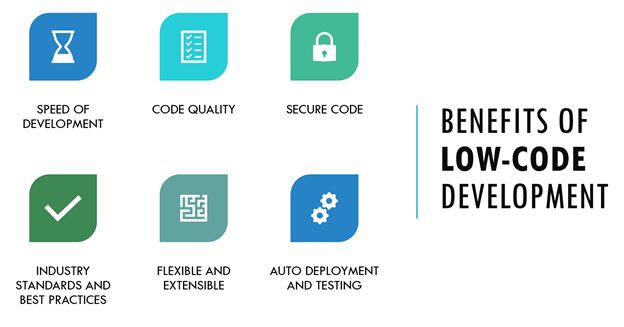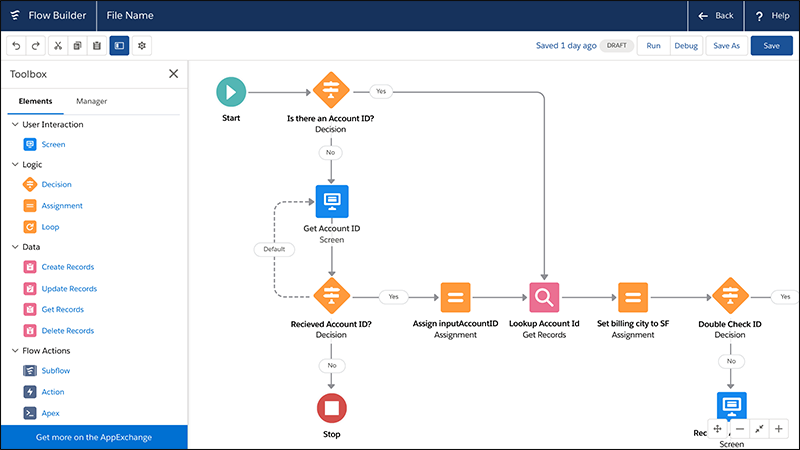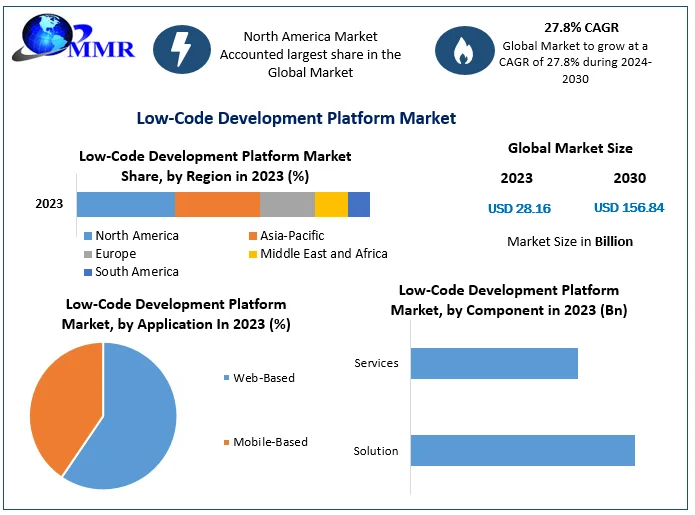Top Tips To Deciding On Low-Code Platform Sites
Top Tips To Deciding On Low-Code Platform Sites
Blog Article
Advantages Of Low-Code Application Development In Terms Of Speed
Visual Development Environment :
Drag-and-Drop Interfaces: Low-code platforms provide visual tools for designing applications. Developers can utilize drag-and-drop tools to quickly assemble applications without writing extensive code.
Pre-built Templates and Components: Many low-code platforms come with already-built templates and components that allow developers to quickly develop and test applications without having to start from scratch.
Reducing Coding requirements
Automated Coding Generation: Low code platforms automatically generate code based on the visual model created by the developers. This eliminates the need to manually code and speeds up development.
Reusable Components : Developers can reuse components from different projects, thereby reducing the amount of time they spend writing and testing codes.
Collaboration Streamlined:
Low-code development platforms are often equipped with tools such as deployment control, version control and testing. This enables seamless collaboration between teams.
Citizen Development: Non-developers and business users can benefit from simple interfaces to help in the creation of applications, which can reduce bottlenecks caused due to a shortage of professional developers.
Rapid prototyping, rapid iteration, and rapid prototyping
Rapid prototyping: Developers are able to quickly build prototypes that can be used to test ideas and get feedback, resulting in quicker the cycle of iterations.
Easy Modifications: Low-code design is oriented towards visuals, which makes it easier to change and update applications. It also speeds the process of improving and enhancing applications in response to user feedback.
Pre-built Integrations:
API Integrations. Many low-code platforms include connectors built for popular APIs and services. This can make it easier to integrate systems.
Data Integration: The instruments that are built in the software make it easier and accelerate the process of connecting databases, data sources, and applications.
Scaling and deployment:
One-Click Deployment: Many low-code platforms have the option of deploying with one click, drastically decreasing the amount of amount of time and effort required to deploy apps.
Cloud-based solutions: Cloud-based low-code platforms are able to handle scaling and infrastructure management which allows developers to concentrate on the logic of their applications and functions rather than deployment logistics.
Overall, low-code development has the advantage of speed because of its capability to automate and simplify many aspects of development. This allows for quicker app delivery and a simpler adaptation to changing needs. Read the top rated your input here on Low-code Platform for application development for website advice including rapid app development, azure sql server, push notifications, rapid action development, mobile app development platforms, rad development, app modernisation, app dev platform, developing mobile apps, build a docker container and more.
The Benefits Of Low-Code Development For Governance And Security
Low-code development can bring many advantages in terms of security and governance. They are essential for ensuring applications are secure, reliable and well-managed through their entire lifecycle. These are the primary benefits.
Unified Management console: This low-code platform usually provides a central dashboard for administrators to control and monitor all applications to ensure consistency in governance throughout the entire organization.
Role-Based Access Control: These platforms include robust role-based control that lets administrators define rules and enforce these policies. It makes sure that only users with authorization can modify or access certain parts of the software.
Compliance and Regulatory Adherence
Many low-code platforms come with built-in compliance functions. These are designed to ensure that apps comply with the industry standard (e.g. GDPR, HIPAA). They provide tools and templates to ensure that the applications are compliant with these requirements.
Audit Trails: Many companies incorporate comprehensive audit and logging trail systems that allow them to keep track of changes as well as track access, and ensure that they are in compliance with internal as well as external regulations.
Increased Security Measures
Data Encryption. Low-code platforms offer encryption for data both at rest and when it is transmitted to ensure that sensitive data is kept safe.
Security Certifications Many low-code sellers have security certificates (e.g. ISO 27001, SOC 2 ) that demonstrate compliance with high security standards. This gives additional security to users.
Automated Security Updates
Regular Security Updates and Patches Low-code platforms handle automated security patches, updates and upgrades. Thus, applications are protected from the latest threats without the need for developer intervention manually.
Security Monitoring - Continuous monitoring for security is typically comprised. This provides real-time insights and alerts regarding possible security threats.
Data Governance
Data Access Policies: These tools allow organisations to define the data access policies, enforce them and keep track of policies. This ensures that data is only accessible to authorized users and used correctly.
Data Masking Anonymization The built-in tools for data masking and features to anonymize data help protect sensitive data, particularly during development and testing environments.
Consistent Application Management
Pipelines for Development and Delivery: Low-code platforms often have integrated development pipelines as well as delivery pipelines which incorporate security tests. Security is ensured throughout the lifecycle.
Version Control. The integrated version management system helps identify and reverse any modifications that are made to the program, while ensuring that the integrity of it is preserved.
Authorization, User Authentication and Authorization
Single Sign-On (SSO): Single sign-on support as well as other advanced authentication techniques makes managing users easier and increases security.
Multi-Factor Authentication (MFA): Many platforms offer built-in support for multi-factor authentication. It adds an additional layer of security to access applications.
Monitoring Policy Enforcement:
Low-code platforms usually come with pre-defined policies templates that help organizations implement security and governance policies swiftly.
Compliance Monitoring Tools: These tools provide continuous monitoring and reporting about compliance levels, making it easier to recognize and resolve possible issues in advance.
Integrate with existing security infrastructure:
Seamless Integration: Low-code platforms have been designed to be integrated with existing security tools and infrastructure, like identity management systems and SIEM (Security Information and Event Management) solutions, and firewalls.
API Security: Built-in API security features ensure that integrations with other systems are secure, securing data and maintaining application integrity.
Training and Best Practices
Guided Best Practices: A number of platforms provide guidelines and best methods for secure application development, helping non-developers adhere to security guidelines.
Security Training: Some low-code vendors offer security training as well as resources that help users understand how to design and build secure applications.
Overall the governance and security advantages of low-code application development ensure that applications are built and operated in a secure as well as compliant manner. These platforms come with all the tools and frameworks necessary to safeguard sensitive information and enforce policies while maintaining the regulatory compliance. See the top rated Enterprise application development with Low-code Platform info for more recommendations including cross platform app dev, low code development platforms, application modernization software, rapid action development, cloud software applications, develop web app, azure sql, azure sql databases, database in azure, mobile app development platforms and more.
Low-Code Apps Can Provide Benefits In The Area Of Collaboration And Workflow
Low-code application development offers several advantages in terms of collaboration and workflow, which makes it an an ideal choice for businesses seeking to improve team efficiency and speed up development processes. Here are the top advantages: Improved Cross-Functional Collaboration:
Unified Development Environment : Low-code platforms provide a unified, one-stop environment in which all team members are able to work effectively, including designers, business analysts and others. This reduces silos and promotes better communication.
Visual Development Tools - The drag and drop visual nature of low-code platforms allows non-technical personnel to take part in the process. This ensures that all requirements of the business are captured and implemented accurately.
Communication Enhancement
Real-Time Collaboration Many low-code applications include real-time features, such as editing and commenting simultaneously or instant feedback. This enables continuous communication, which can to reduce the amount of time spent on back-and-forth discussions.
Workspaces shared by teams. Teams can collaborate through shared workspaces. Here, they can view, edit and discuss various project components.
A streamlined Workflow Management System:
Integrated Project Management Tools: Many low-code platforms have integrated tools for managing projects which can assist teams to track and manage their projects for development. This includes tasks management, progress tracking and management of deadlines.
Workflow Automation: Automating repetitive tasks and workflows reduces errors and manual labor which allows teams to concentrate on more strategic work and enhancing overall efficiency.
Speedier iteration cycles:
Rapid prototyping. A low-code platform allows rapid prototyping. This ensures feedback can be quickly integrated and changes can be made.
Support for Agile Methodologies: Supporting agile methods gives teams the ability to run sprints and continually provide small amounts of functionalities that make it easier to adjust to changing requirements.
Accessibility for Non-Developers:
Citizen Development: Low-code platforms allow users in the business (citizen developers) to develop and modify applications with no coding expertise. This reduces the burden on IT teams as well as developers, enabling them to respond faster to business needs.
Training and Onboarding Simple interfaces and extensive training resources make it easier for new members of the team to learn the ropes and improve the overall cohesion within the team.
Centralized Documentation, Knowledge Sharing and Information Sharing
Integrated documentation Platform features that are low-code usually permit you to create and manage documents within the platform. All information about your project will be centralized and easily accessible.
Knowledge Repositories : Teams can create knowledge repositories. These contain templates, best practices, and reuseable components. This allows for sharing of knowledge and reduces duplication of efforts.
Consistency Standardization, Consistency and Standards:
Standardized Components: The use standardized, pre-built components provides uniformity across different applications, making it simpler for teams to comprehend and work on different parts of the project.
Governance and compliance: Integrated governance frameworks help ensure that development is in line with regulations and standards of the organization. This lowers the risk of non-compliance and also helps applications comply with quality standards.
Feedback Loops and Improvement Loops
Integrated Feedback mechanisms: Low-code platforms often have integrated feedback mechanism, which allows users to provide feedback on the application. Feedback can then become incorporated into development.
Continuous Improvement: The capability to rapidly iterate and deploy changes based on feedback ensures constant improvement of software that are in line to the requirements of the users and business goals.
Visualization & Reporting
Real-time analytics The built-in analytical and reporting features give real-time insight into the performance of your project, its progress and user interaction. They allow data-driven, informed decision-making.
Visual Workflow Mapping Visual tools that visualize workflows and processes can assist teams in optimizing their workflow by identifying bottlenecks.
Low-code development of applications is a powerful tool to collaborate and streamline workflow. It connects disparate teams, simplifies communication and automates processes. This fosters a more collaborative, efficient, and agile development environment, ultimately leading to higher-quality applications and better aligning with the business objectives.